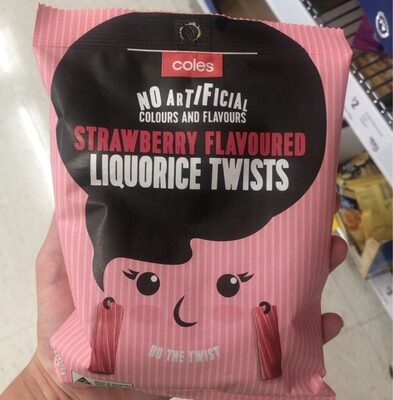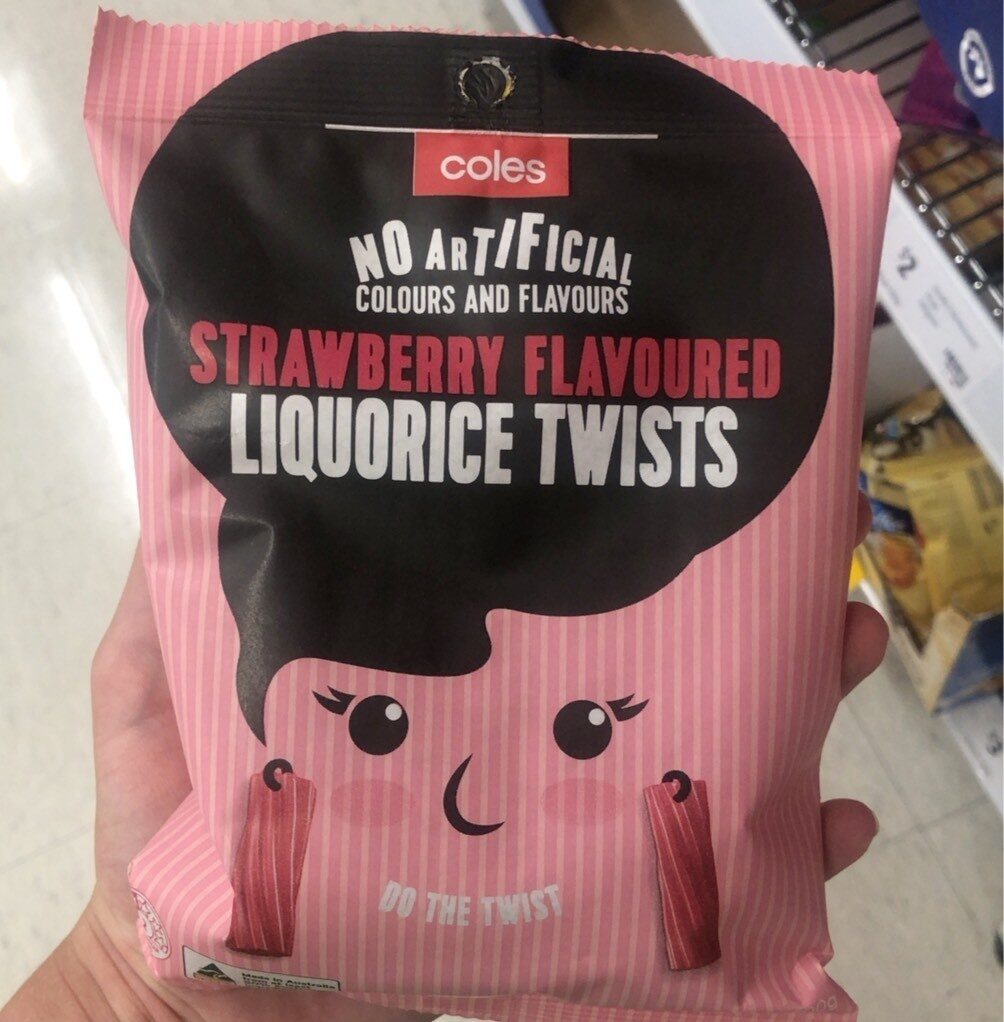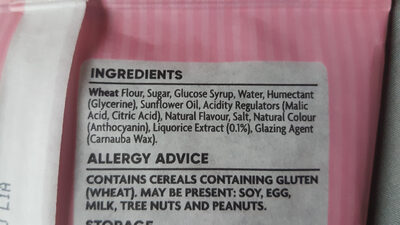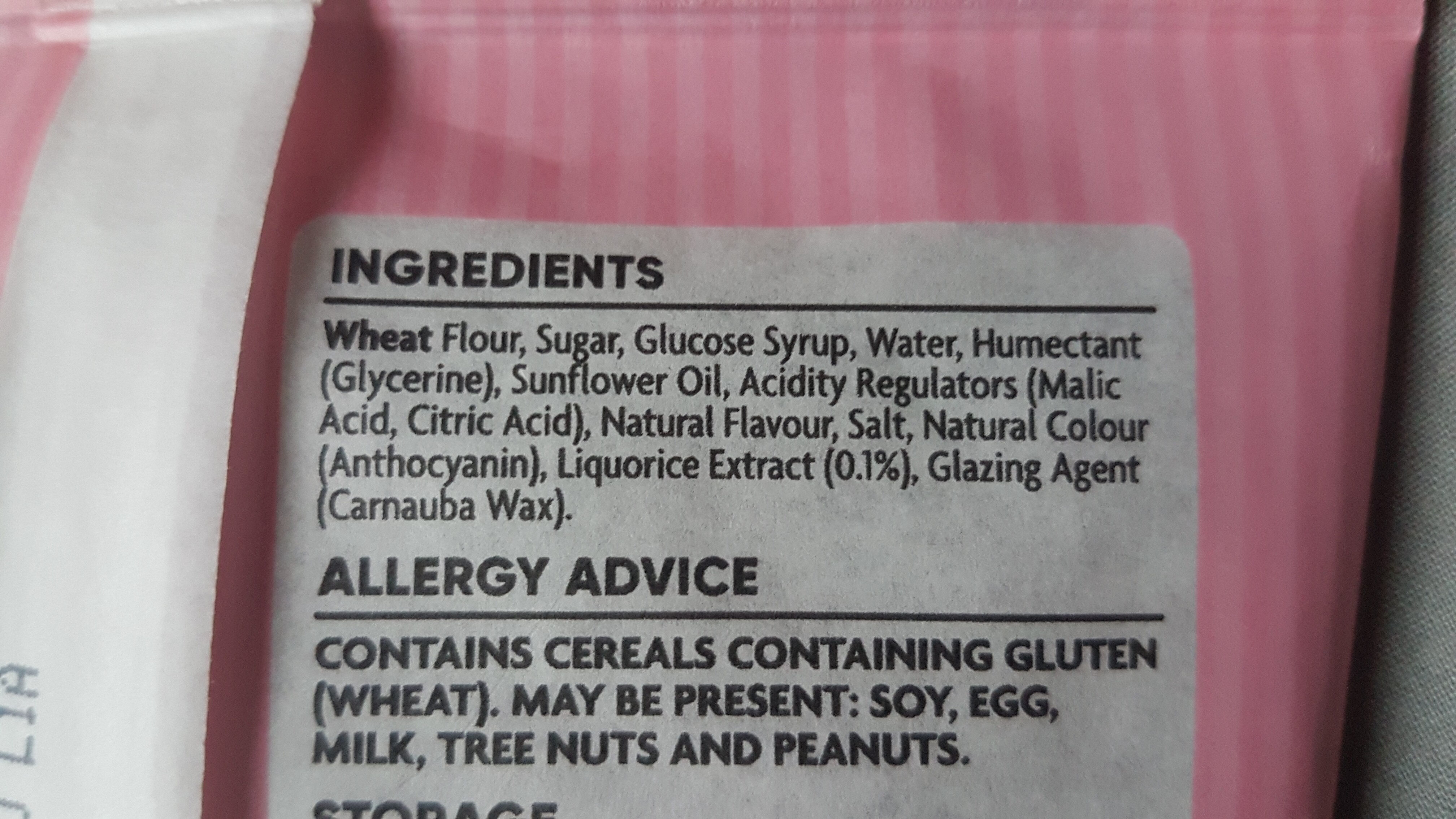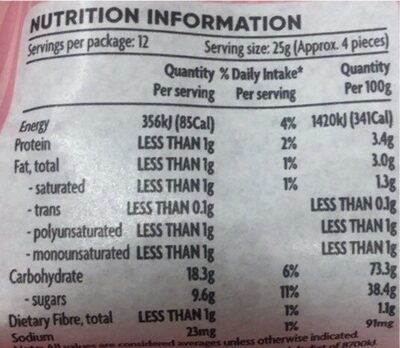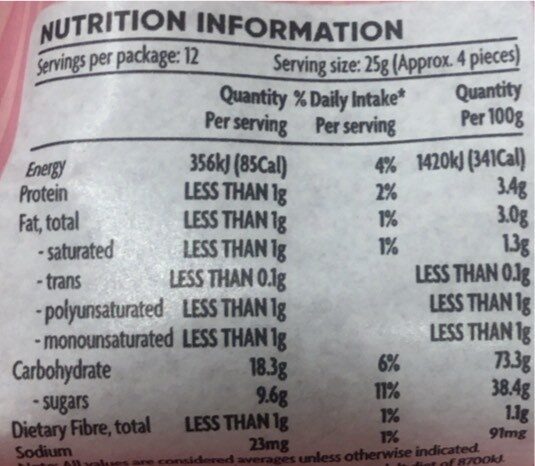Help us make food transparency the norm!
As a non-profit organization, we depend on your donations to continue informing consumers around the world about what they eat.
The food revolution starts with you!
Strawberry liqurice - Coles - 300 g
Strawberry liqurice - Coles - 300 g
This product page is not complete. You can help to complete it by editing it and adding more data from the photos we have, or by taking more photos using the app for Android or iPhone/iPad. Thank you!
×
Barcode: 9310645344355 (EAN / EAN-13)
Quantity: 300 g
Packaging: Plastic
Brands: Coles
Categories: Snacks, Sweet snacks, Confectioneries, Fruit confectioneries, Candies, Liquorice candies
Labels, certifications, awards: Vegetarian, No artificial flavors, Australian made, No artificial colors, No artificial colours or flavours
Origin of ingredients: Australia
Manufacturing or processing places: Australia
Link to the product page on the official site of the producer: https://shop.coles.com.au/a/national/pro...
Stores: Coles
Countries where sold: Australia
Matching with your preferences
Health
Ingredients
-
18 ingredients
WHEAT Flour, Sugar, Glucose Syrup, Water, Humectant (Glycerine), Sunflower Oil, Acidity Regulators (Malic Acid, Citric Acid), Natural Flavour, Salt, Natural Colour (Anthocyanin), Liquorice Extract (0.1%), Glazing Agent (Carnauba Wax). ALLERGY ADVICE CONTAINS CEREALS CONTAINING GLUTEN (WHEAT). MAY BE PRESENT: SOY, EGG, MILK, TREE NUTS AND PEANUTS.Allergens: GlutenTraces: Eggs, Milk, Nuts, Peanuts, Soybeans
Food processing
-
Ultra processed foods
Elements that indicate the product is in the 4 - Ultra processed food and drink products group:
- Additive: E163 - Anthocyanins
- Additive: E422 - Glycerol
- Additive: E903 - Carnauba wax
- Ingredient: Colour
- Ingredient: Flavouring
- Ingredient: Glazing agent
- Ingredient: Glucose
- Ingredient: Glucose syrup
- Ingredient: Humectant
Food products are classified into 4 groups according to their degree of processing:
- Unprocessed or minimally processed foods
- Processed culinary ingredients
- Processed foods
- Ultra processed foods
The determination of the group is based on the category of the product and on the ingredients it contains.
Additives
-
E163 - Anthocyanins
Anthocyanin: Anthocyanins -also anthocyans; from Greek: ἄνθος -anthos- "flower" and κυάνεος/κυανοῦς kyaneos/kyanous "dark blue"- are water-soluble vacuolar pigments that, depending on their pH, may appear red, purple, or blue. Food plants rich in anthocyanins include the blueberry, raspberry, black rice, and black soybean, among many others that are red, blue, purple, or black. Some of the colors of autumn leaves are derived from anthocyanins.Anthocyanins belong to a parent class of molecules called flavonoids synthesized via the phenylpropanoid pathway. They occur in all tissues of higher plants, including leaves, stems, roots, flowers, and fruits. Anthocyanins are derived from anthocyanidins by adding sugars. They are odorless and moderately astringent. Although approved to color foods and beverages in the European Union, anthocyanins are not approved for use as a food additive because they have not been verified as safe when used as food or supplement ingredients. There is no conclusive evidence anthocyanins have any effect on human biology or diseases.Source: Wikipedia
-
E296 - Malic acid
Malic acid: Malic acid is an organic compound with the molecular formula C4H6O5. It is a dicarboxylic acid that is made by all living organisms, contributes to the pleasantly sour taste of fruits, and is used as a food additive. Malic acid has two stereoisomeric forms -L- and D-enantiomers-, though only the L-isomer exists naturally. The salts and esters of malic acid are known as malates. The malate anion is an intermediate in the citric acid cycle.Source: Wikipedia
-
E330 - Citric acid
Citric acid is a natural organic acid found in citrus fruits such as lemons, oranges, and limes.
It is widely used in the food industry as a flavor enhancer, acidulant, and preservative due to its tart and refreshing taste.
Citric acid is safe for consumption when used in moderation and is considered a generally recognized as safe (GRAS) food additive by regulatory agencies worldwide.
-
E422 - Glycerol
Glycerol: Glycerol -; also called glycerine or glycerin; see spelling differences- is a simple polyol compound. It is a colorless, odorless, viscous liquid that is sweet-tasting and non-toxic. The glycerol backbone is found in all lipids known as triglycerides. It is widely used in the food industry as a sweetener and humectant and in pharmaceutical formulations. Glycerol has three hydroxyl groups that are responsible for its solubility in water and its hygroscopic nature.Source: Wikipedia
-
E903 - Carnauba wax
Carnauba wax: Carnauba -; Portuguese: carnaúba [kaʁnɐˈubɐ]-, also called Brazil wax and palm wax, is a wax of the leaves of the palm Copernicia prunifera -Synonym: Copernicia cerifera-, a plant native to and grown only in the northeastern Brazilian states of Piauí, Ceará, Maranhão, Bahia, and Rio Grande do Norte. It is known as "queen of waxes" and in its pure state, usually comes in the form of hard yellow-brown flakes. It is obtained from the leaves of the carnauba palm by collecting and drying them, beating them to loosen the wax, then refining and bleaching the wax.Source: Wikipedia
Ingredients analysis
-
Palm oil free
No ingredients containing palm oil detected
-
Maybe vegan
Ingredients that may not be vegan: E422, Natural flavouring
-
Vegetarian
No non-vegetarian ingredients detected
-
Details of the analysis of the ingredients
: WHEAT Flour, Sugar, Glucose Syrup, Water, Humectant (Glycerine), Sunflower Oil, Acidity Regulators (Malic Acid, Citric Acid), Natural Flavour, Salt, Natural Colour (Anthocyanin), Liquorice Extract 0.1%, Glazing Agent (Carnauba Wax, WHEAT)- WHEAT Flour -> en:wheat-flour - vegan: yes - vegetarian: yes - ciqual_proxy_food_code: 9410 - percent_min: 8.33333333333333 - percent_max: 99
- Sugar -> en:sugar - vegan: yes - vegetarian: yes - ciqual_proxy_food_code: 31016 - percent_min: 0.1 - percent_max: 38.4
- Glucose Syrup -> en:glucose-syrup - vegan: yes - vegetarian: yes - ciqual_proxy_food_code: 31016 - percent_min: 0.1 - percent_max: 33.0666666666667
- Water -> en:water - vegan: yes - vegetarian: yes - ciqual_food_code: 18066 - percent_min: 0.1 - percent_max: 24.825
- Humectant -> en:humectant - percent_min: 0.1 - percent_max: 19.88
- Glycerine -> en:e422 - vegan: maybe - vegetarian: maybe - percent_min: 0 - percent_max: 19.88
- Sunflower Oil -> en:sunflower-oil - vegan: yes - vegetarian: yes - from_palm_oil: no - ciqual_food_code: 17440 - percent_min: 0.1 - percent_max: 16.5833333333333
- Acidity Regulators -> en:acidity-regulator - percent_min: 0.1 - percent_max: 14.2285714285714
- Malic Acid -> en:e296 - vegan: yes - vegetarian: yes - percent_min: 0 - percent_max: 14.2285714285714
- Citric Acid -> en:e330 - vegan: yes - vegetarian: yes - percent_min: 0 - percent_max: 7.11428571428571
- Natural Flavour -> en:natural-flavouring - vegan: maybe - vegetarian: maybe - percent_min: 0.1 - percent_max: 5
- Salt -> en:salt - vegan: yes - vegetarian: yes - ciqual_food_code: 11058 - percent_min: 0.1 - percent_max: 0.23
- Natural Colour -> en:natural-colours - percent_min: 0.1 - percent_max: 0.23
- Anthocyanin -> en:e163 - vegan: yes - vegetarian: yes - percent_min: 0 - percent_max: 0.23
- Liquorice Extract -> en:liquorice-extract - vegan: yes - vegetarian: yes - percent_min: 0.1 - percent: 0.1 - percent_max: 0.1
- Glazing Agent -> en:glazing-agent - percent_min: 0 - percent_max: 0.1
- Carnauba Wax -> en:e903 - vegan: yes - vegetarian: yes - percent_min: 0 - percent_max: 0.1
- WHEAT -> en:wheat - vegan: yes - vegetarian: yes - ciqual_proxy_food_code: 9410 - percent_min: 0 - percent_max: 0.1
Nutrition
-
Poor nutritional quality
⚠ ️Warning: the amount of fruits, vegetables and nuts is not specified on the label, it was estimated from the list of ingredients: 0This product is not considered a beverage for the calculation of the Nutri-Score.
Positive points: 4
- Proteins: 2 / 5 (value: 4, rounded value: 4)
- Fiber: 4 / 5 (value: 4, rounded value: 4)
- Fruits, vegetables, nuts, and colza/walnut/olive oils: 0 / 5 (value: 0, rounded value: 0)
Negative points: 16
- Energy: 4 / 10 (value: 1420, rounded value: 1420)
- Sugars: 8 / 10 (value: 38.4, rounded value: 38.4)
- Saturated fat: 3 / 10 (value: 4, rounded value: 4)
- Sodium: 1 / 10 (value: 92, rounded value: 92)
The points for proteins are not counted because the negative points are greater or equal to 11.
Nutritional score: (16 - 4)
Nutri-Score:
-
Nutrient levels
-
Fat in moderate quantity (4%)
What you need to know- A high consumption of fat, especially saturated fats, can raise cholesterol, which increases the risk of heart diseases.
Recommendation: Limit the consumption of fat and saturated fat- Choose products with lower fat and saturated fat content.
-
Saturated fat in moderate quantity (4%)
What you need to know- A high consumption of fat, especially saturated fats, can raise cholesterol, which increases the risk of heart diseases.
Recommendation: Limit the consumption of fat and saturated fat- Choose products with lower fat and saturated fat content.
-
Sugars in high quantity (38.4%)
What you need to know- A high consumption of sugar can cause weight gain and tooth decay. It also augments the risk of type 2 diabetes and cardio-vascular diseases.
Recommendation: Limit the consumption of sugar and sugary drinks- Sugary drinks (such as sodas, fruit beverages, and fruit juices and nectars) should be limited as much as possible (no more than 1 glass a day).
- Choose products with lower sugar content and reduce the consumption of products with added sugars.
-
Salt in low quantity (0.23%)
What you need to know- A high consumption of salt (or sodium) can cause raised blood pressure, which can increase the risk of heart disease and stroke.
- Many people who have high blood pressure do not know it, as there are often no symptoms.
- Most people consume too much salt (on average 9 to 12 grams per day), around twice the recommended maximum level of intake.
Recommendation: Limit the consumption of salt and salted food- Reduce the quantity of salt used when cooking, and don't salt again at the table.
- Limit the consumption of salty snacks and choose products with lower salt content.
-
-
Nutrition facts
Nutrition facts As sold
for 100 g / 100 mlAs sold
per serving (25g)Compared to: Liquorice candies Energy 1,420 kj
(340 kcal)355 kj
(85 kcal)+5% Fat 4 g 1 g +384% Saturated fat 4 g 1 g +695% Monounsaturated fat < 1 g < 0.25 g Polyunsaturated fat < 1 g < 0.25 g Trans fat < 0.1 g < 0.025 g Carbohydrates 73.2 g 18.3 g -3% Sugars 38.4 g 9.6 g -14% Fiber 4 g 1 g +26% Proteins 4 g 1 g +46% Salt 0.23 g 0.058 g -48% Alcohol 0 % vol 0 % vol Fruits‚ vegetables‚ nuts and rapeseed‚ walnut and olive oils (estimate from ingredients list analysis) 0 % 0 %
Environment
-
Eco-Score C - Moderate environmental impact
⚠ ️Select a country in order to include the full impact of transportation.The Eco-Score is an experimental score that summarizes the environmental impacts of food products.→ The Eco-Score was initially developped for France and it is being extended to other European countries. The Eco-Score formula is subject to change as it is regularly improved to make it more precise and better suited to each country.Life cycle analysis
-
Average impact of products of the same category: B (Score: 62/100)
Category: Candies, all types
Category: Candies, all types
- PEF environmental score: 0.41 (the lower the score, the lower the impact)
- including impact on climate change: 1.73 kg CO2 eq/kg of product
Stage Impact Agriculture
78.2 %Processing
10.7 %Packaging
5.5 %Transportation
4.5 %Distribution
1.1 %Consumption
0.0 %
Bonuses and maluses
-
Origins of ingredients with a medium impact
Bonus: +3
Environmental policy: +3
Transportation: 0
Origin of the product and/or its ingredients % of ingredients Impact Australia 100 %Medium
-
Packaging with a medium impact
Malus: -10
Shape Material Recycling Impact Unknown Plastic High ⚠ ️ The information about the packaging of this product is not sufficiently precise (exact shapes and materials of all components of the packaging).⚠ ️ For a more precise calculation of the Eco-Score, you can modify the product page and add them.
If you are the manufacturer of this product, you can send us the information with our free platform for producers.
Eco-Score for this product
-
Impact for this product: C (Score: 55/100)
Product: Strawberry liqurice - Coles - 300 g
Life cycle analysis score: 62
Sum of bonuses and maluses: -7
Final score: 55/100
-
Carbon footprint
-
Equal to driving 0.9 km in a petrol car
173 g CO² per 100g of product
The carbon emission figure comes from ADEME's Agribalyse database, for the category: Candies, all types (Source: ADEME Agribalyse Database)
Stage Impact Agriculture
52.3 %Processing
19.5 %Packaging
15.7 %Transportation
11.6 %Distribution
1.0 %Consumption
0.0 %
Packaging
-
Packaging with a medium impact
-
Packaging parts
(Plastic)
-
Packaging materials
Material % Packaging weight Packaging weight per 100 g of product Plastic
-
Transportation
-
Origins of ingredients
Origins of ingredients with a medium impact
Origin of the product and/or its ingredients % of ingredients Impact Australia 100 %Medium
Report a problem
-
Incomplete or incorrect information?
Category, labels, ingredients, allergens, nutritional information, photos etc.
If the information does not match the information on the packaging, please complete or correct it. Open Food Facts is a collaborative database, and every contribution is useful for all.
Data sources
Product added on by hisham
Last edit of product page on by kiliweb.
Product page also edited by ecoscore-impact-estimator, openfoodfacts-contributors, yuka.sY2b0xO6T85zoF3NwEKvlk5MD8jCqALFaTjnwm-Jm8yzf4HCYI1AxIL_aas.
